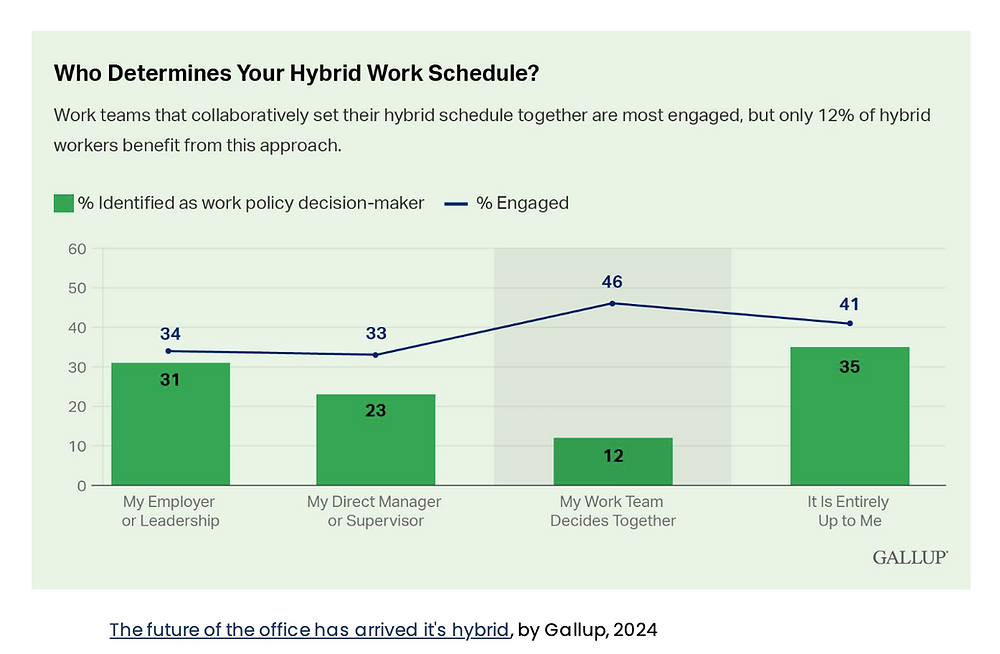
Balancing Flexibility & Connection: How Human Managers shape strong cultures across diverse and disparate teams
0
7
0

Coordinating teams used to mean managing diaries and meetings. Now, it’s about so much more:
➡ Aligning distributed, diverse people
➡ Fostering connection and culture from afar
➡ Creating space for focus and flexibility
➡ And doing all of that while maintaining momentum and rhythm
In this new world, great managers don’t just “manage” — they orchestrate. They create the conditions where people can thrive, collaborate and stay connected in ways that feel human and productive.
But here’s the catch: this doesn’t happen by accident. It takes intentionality, tools, and systems that support human connection.
📊 The Research Is Clear: Coordination Drives Engagement
According to Gallup’s 2024 report on hybrid work, when teams work together to coordinate their schedules and ways of working, they’re far more engaged.
But — only 12% of teams were doing this collaboratively.
Managers don’t need to dictate schedules. What they need to do is facilitate the conversations that lead to smart, shared approaches. They must help teams find their own rhythm — balancing flexibility with structure, and autonomy with alignment.
💡 Case Study: Dropbox & “Virtual First”
Dropbox’s “Virtual First” model shows how to do this well. While their teams mostly work remotely, they intentionally design in-person gatherings that serve different goals — like trust-building, creativity, or decision-making.
Their approach includes intentionally building moments of connection:
🧳 Retreat-style off-sites – for team bonding and innovation
🧰 Co-working weeks – for focused collaboration on specific goals
🗓 Centralised planning support – to reduce admin and make gatherings easier
🧭 Company-wide calendars – for visibility and coordination across functions
The takeaway? Hybrid doesn’t mean disconnected. With the right rituals and rhythms, it can unlock even better ways of working.

✨ Creating Belonging Through Rituals
Beyond coordination, belonging is the fuel that powers great teams. Managers play a crucial role here too—not through grand gestures, but through small, human rituals done consistently:
Weekly gratitude rounds
Walking 1:1s
Celebrating team wins
Personal check-ins at the start of meetings
Learning circles
“Failure shares” to normalise mistakes
These micro-habits build psychological safety, fuel connection, and shape team culture —often more than any corporate policy ever could.
🎯 Leader Exercise: Design Your Team’s Rhythm & Rituals
Use this simple 3-part exercise to map out your team’s current rhythm and intentionally design new ways of working together.
🧩 Step 1: Map Your Moments That Matter
Take 5–10 minutes to reflect on the key moments in your team’s month or quarter. These might include:
Onboarding a new team member
Quarterly planning
End-of-sprint demos
Conflict resolution
Celebrating milestones
Performance reviews
Project launches
Leadership check-ins
Ask:
👉 Which of these moments are happening well?
👉 Where is connection missing?
👉 What could we do more intentionally?
🔄 Step 2: Balance Flexibility & Connection
Now, review how your team currently coordinates work.
Ask yourself:
Do we have clear rhythms for connection? (e.g. weekly stand-ups, retros, planning sessions)
Do people feel they have enough flexibility to focus, reset, and recharge?
Do we plan collaboratively—or are people guessing what’s expected?
Then, design a simple rhythm:
🗓 Weekly: e.g. Check-in Mondays, Focus Fridays
🔁 Monthly: e.g. Strategy sync, growth 1:1s
🌍 Quarterly: e.g. Retreat day or offsite, innovation workshop
Let your team co-create this rhythm with you.
🪴 Step 3: Define Your Team Rituals
As a manager, think about the signature rituals that make your team culture feel alive.
Use these prompts to sketch your own “culture commitments”:
How do we start meetings?
How do we celebrate wins?
How do we recover from mistakes?
How do we share ideas and feedback?
How do we welcome someone new?
What makes people feel like they belong here?
Invite your team into the process — ask what they value most.
Then, commit to 1–2 rituals you’ll carry forward intentionally. Start small, stay consistent, and let them evolve.
🧠 Final Thought: Human Work Needs Human Systems
Hybrid isn’t the challenge — how we lead in hybrid is.
When managers are equipped to balance flexibility and connection, teams don’t just perform — they flourish.
Let’s support our managers not just with tools and tasks, but with space to design team experiences that are meaningful, motivating and human.
For further insights download our 1-pager: Some moments matter more when it comes to nurturing trust and belonging — linked below.
And join the Make It Human Club for regular insights, tools and support on shaping cultures where people and business grow.




